Motor Power Ratings
Why don't you list the rated watts of each motor?
Simple Answer
The reason we don't have a simple power level for each motor or kit is that there is no standard or even consistent way to provide a numeric "watts rating" for a motor system. You can see the exact same motor listed as 250 watts, 500 watts, and 1000 watts by different vendors, and there is a valid justification for all those number. That makes a vendor or manufacturer's watts rating in isolation a fairly pointless figure for choosing or comparing setups, and we're not keen to particiate in that kind of arbitrary numbers game.
Instead, we give a ballpark range (like 250-500 watts, 600-1200 watts etc.) in which the motor is typically used and have provided a useful and accurate motor simulator tool that will show you the exact output power for any combination of motor, controller, and battery pack; not just as an arbitrary single number but over the entire speed range of the vehicle. This is considerably more valuable for understanding a system's performance. You can see things like the peak output power, the output power at your predicted cruising speed under any kind of hill or vehicle type, and whether the motor may be prone to overheating at a given load. Check it out:
www.ebikes.ca/simulator
Justin's Complete Rant
OK, for those not satisfied with the paragraphs above and interested in the full technical lowdown, then read on. We get asked this question "what's the power rating of this motor" all the time and it is both an astute and infuriating question to be asked.
It is astute because more than anything else, the specific output power of an electric bike motor (in watts) determines exactly how an ebike will perform and handle a given situation. 600 watts of mechanical power will cause a bike to behave the same whether it is coming from a small geared hub motor, a massive direct drive hub motor, a mid-drive motor, or a giant gust of tail wind. If you need 600 watts of power to climb a certain hill at a certain speed, but your motor is only capable of producing 300 watts, then either you'll have to make up the shortfall with your legs, or your bike will slow down until only 300 watts is needed. An actual watt is a watt of power, no matter where it comes from.
It's tempting to think that if your usage case requires 600 watts of mechanical power, then you should get a motor rated for at least 600 watts, simple right, a watt is a watt? And if one company sells a kit rated for 750 watts, that will be more powerful than a different kit rated at 500 watts correct? But there's a problem, and this is where things get infuriating in our efforts a explaining things to people.
While an actual watt is an actual watt, There is NO SUCH THING as a "rated watt" or any standarized method for rating ebike motor power. That's the truth, regardless of what other companies imply. With most electrical devices the term rated power has a very clear meaning. Like a 60 watt lightbulb can be counted on to draw 60 watts of power when it is turned on. A 1500 watt heater will produce 1500 watts of heat, regardless of which brand or model you use.
With electric motors, they do not produce a fixed amount of power when you turn them on. If you run the motor with your wheel off the ground, then it will spin at full speed and produce no power output. As you then load the motor with drag, it will slow down a bit and produce torque, and the more you load it down the more it slows down and the higher the torque and power it puts out. At some point as you continue to load and slow the motor down, then the output power will start to decrease. Even though the torque is still increasing, the lower RPM means that the mechanical power produced goes down. If you stall the motor completely, it might be making a ton of torque but it's producing zero output power.
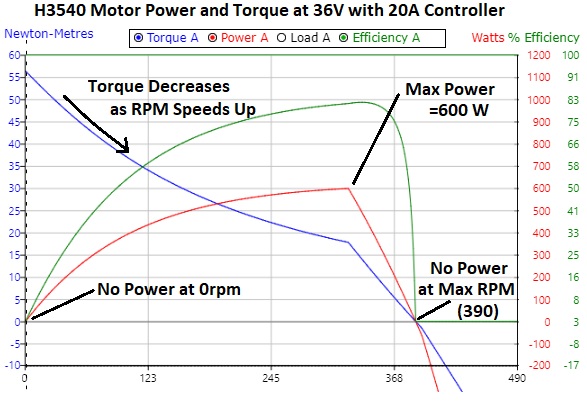

The actual power output of a motor depends entirely on how heavily it is loaded in a given situation and the maximum electrical power that the controller lets flow into the motor, it has little to nothing to do with a rating anywhere.The above two graphs show the power curves of the same motor, in one case running with a 36V battery and 20A controller at full throttle producing a peak of 600 watts, in the other case with a 48V battery and a 35A controller at full lthrottle producing a peak of 1100 watts. .
So what limits how much power a motor can produce?

When the motor is loaded down like this to produce power, it also draws more electrical current through the motor windings. This current is responsible for most of the heat being generated inside the motor since the copper windings have electrical resistance. If you double the current through the windings in order to have double the torque and power from the motor, then you increase the amount of copper heat being generated by a factor of FOUR (the I2R relationship).
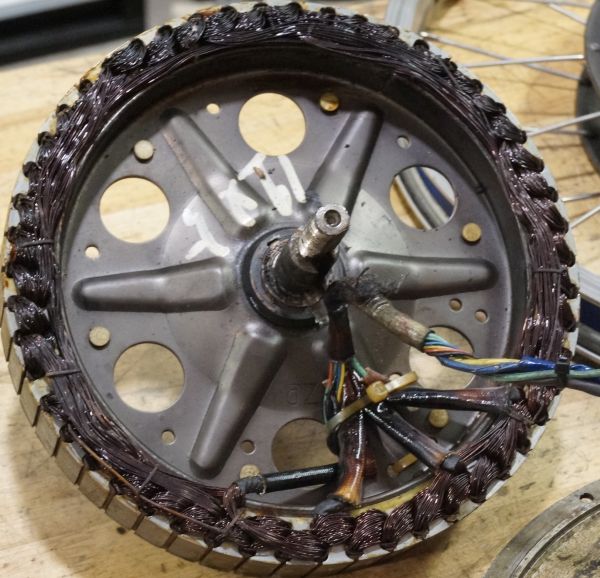
This heat of course causes the motor to warm up. Motors are large heavy chunks of metal, so they can have quite a bit of short term heat thrown at them and not increase in temperature too much. But if the heat continues to accumulate inside the motor windings faster than it can be dissipated to the air outside, then you risk the motor getting so hot that insulation burns off the copper enamel, nylon gears soften and strip, or magnets start to demagnetize. At that point, you have 'burnt up' or 'cooked' your motor. Whether this happens is a function not just of the amps flowing through the motor but also the time over which these high motor currents are sustained.
The difference between power and torque
An important point to realize here is that it's not the output power but the output torque of the motor which causes it to heat up and eventually fail. If you don't remember high school physics lessons, torque is the rotational measurement of force, ie. how hard something is being twisted. It's measured by the product of force times the length of the lever arm.
<diagram of torque equations and graphs, ft-lb, Newton-meters>
Power by contrast is a measurement of how rapidly work is being done. In order for a twisting force to do work it needs to be spinning something, and the faster it spins at a given torque then the more work it will do. Power is the product of torque times the spinning rate, and in SI units where you measure torque in Newton-meters and rotational speed in Rad/sec, then it's simple:
Power in Watts = torque * rad/sec
If you measure speed in rpms, then the power output is
Power in Watts = Torque * RPM * 2Pi/60 ~ Torque * RPM * 0.104
A motor producing 20 Nm of torque and spinning at 100 rpm is generating 209 watts. That same motor producing 20 Nm of torque while spinning at 300 rpm is producing 628 watts. Let's assume that 20 Nm is the maximum torque that this motor can produce without risk of it overheating, do you now call it a 200 watt motor? or a 600 watt motor?
This is one reason why rated motor powers can be all over the map. It is ultimately the torque and not power that causes a motor to overheat. To convert a maximum torque spec into a power rating you need to also specify the RPM at which you decided this rating. However, permanent magnet electric motors in isolation don't intrinsically have an RPM at which they spin at, they'll have an RPM/V winding constant. It's the combination of this winding constant and your battery voltage that determines how fast a motor will be able to spin in a given setup.
So if you specify both a motor and a voltage, then you can make a claim for a rated rpm. But if you are just talking about a motor by itself, it has no intrinsic RPM, the same motor can be run fast or slow by varying the applied voltage, and without any implied RPM at which you run the motor there is no way to talk about how much power it can produce.
What about peak power rating?
The PEAK power output of a given ebike system is very well defined and has no ambiguity like "rated power", but it's not always as useful as you might expect. In general, the peak motor output power occurs right at the point where the motor controller hits the battery current limit. Our online hub motor simulator allows you to see this easily. In the graph below, we have a typical ebike setup composed of a Crystalyte H3540 hub motor, a 36 battery pack, and a 20A motor controller.
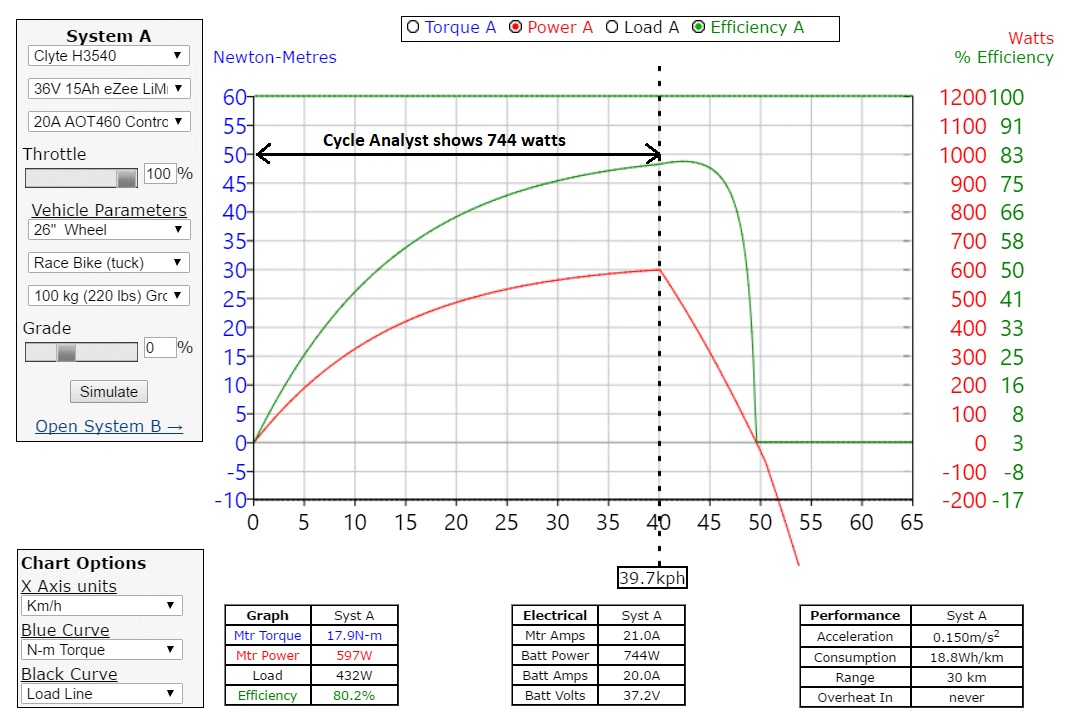
When running full throttle, the motor output power (red graph) peaks at 600 watts at 40 kph. Above this speed, the power and torque of the motor decreases until reaching 0 at about 48kph. Below this peak power speed, the motor controller is current limited and so is clamping the electrical input power to the hub motor. The input power (V*A) as seen on a Cycle Analyst stays constant at 744 watts while the motor's mechanical output power decreases. That's because the motor is less and less efficient as it slows down in this constant input power scenario, which you can see from the green efficiency curve.
Now let's keep the exact same motor and battery but use a higher current 40A motor controller so that the peak input power (volts * amps) is nominally 1440 watts. The graph is identical to the 20A controller above 40 kph, but below this speed the 40A controller setup continues to allow larger power outputs until itself peaking at 1058 watts of output power at 33 kph.
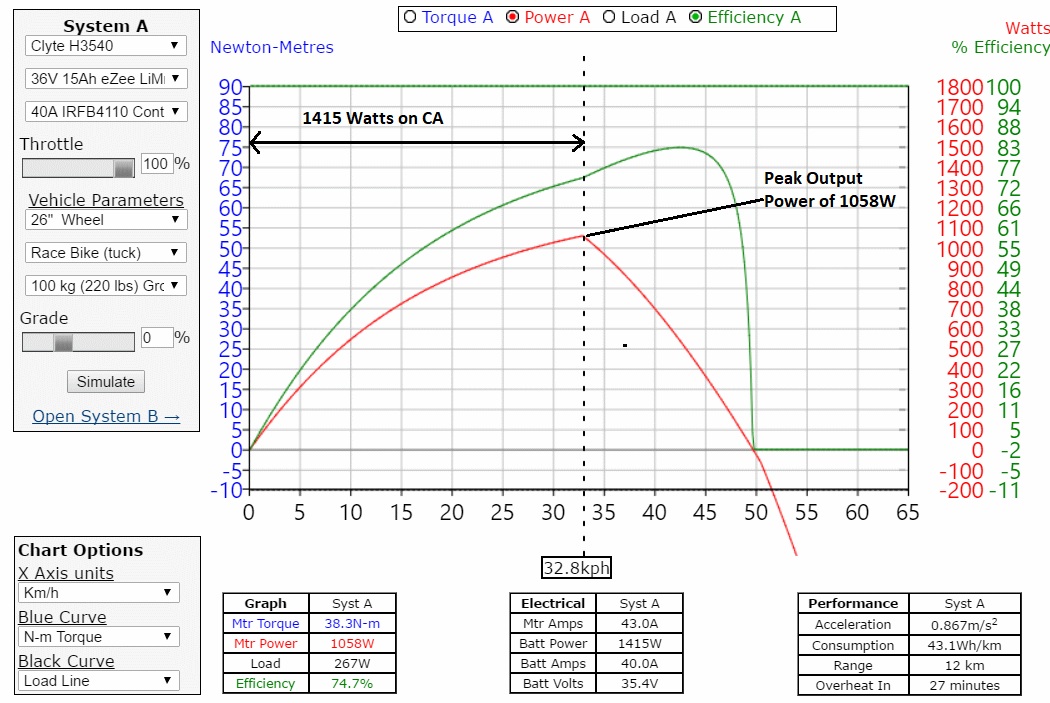
How do these systems compare? Well, the peak power of the 2nd setup is 80% higher than the first one (1058 watts vs 600 watts). If you rode the bike, you would find that it accelerates faster off the line and has more initial punch, but once you got up to 40 kph then the ride feeling would be identical, and in typical cruising situations you would only appreciate the difference between the setups on steeper hill climbs. It would not by any means feel like an 80% more powerful setup, and if you looked at your average power draw on most trips (wh/km) it wouldn't deviate very much because you would typically be cruising at or above 40 kph and your power levels would be the same.
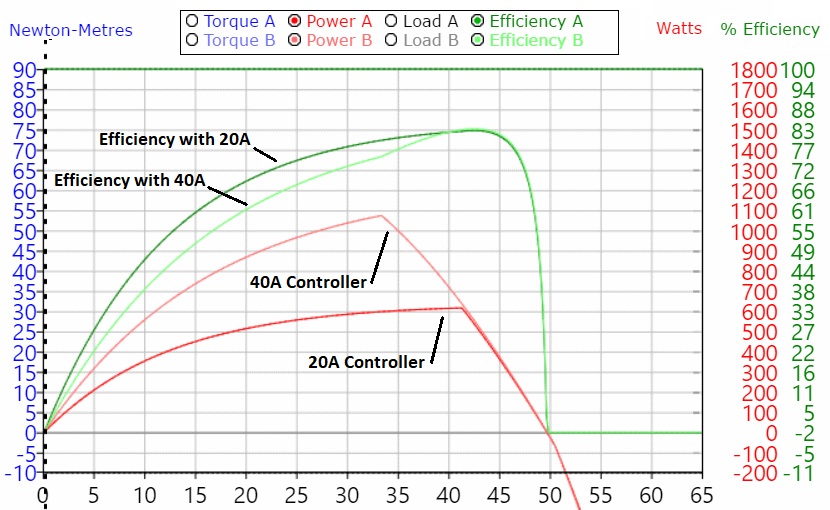
Now lets keep the original 20A controller but increase the battery from 36V to 52V. With this setup, the peak output power is now 840 watts. That's less than the peak power of the 36V 40A arrangement, but if you hopped on this bike and rode it it would likley feel more powerful. The acceleration off the line will be a little bit slower, but then it will keep on accelerating right up to 55+ kph. You'll travel faster, go up most hills faster, and your average power usage will be a lot higher, even though the peak power of the system is less.

So now you see why a comparison of peak motor output power alone doesn't tell the full story on how powerful a system will feel. And you can see too that this peak power is not a motor property since all the above graphs used exactly the same motor, it's actually mostly a function of the motor controller and battery pack. I could swap much smaller or larger motors with the same controller and battery, and the output power levels wouldn't vary by that much.
Rating by peak INPUT power
One common approach for ebike vendors to use when giving a power rating on their kits is to use not the motor output power (peak or otherwise) but the maximum input power as shown on a Cycle Analyst. More often than not we will see people selling a kit with say a 72V battery pack and a 50A motor controller, and they'll advertise it as "3600 watts", even if the particular setup in question might only hit 2000 watts of output power due to poor motor efficiency, and could only sustain half of that again without overheating in very short order.
This is an unfortunate practice as it is misleading, but it's understandable why it came to be. It provides the largest number that you can use for marketting, and it's also the wattage number that any electrical power meter will display. A majority of ebike vendors selling and boasting powerful ebike setups embrace this approach, where the claimed watts exceeds not only the actual peak motor power output (usually by at least ~30%), but often well exceeds by a factor of 2 or 3 the mechanical power the system could output on any kind of sustained basis without overheating.
What about continuous power?
In principle this would seem like a fairest way to compare the relative power of different setups. Rather than talking about the maximum power, you instead compare the continuous power that the motor can output indefinitely without overheating. Then people couldn't just put a high current motor controller and high voltage battery on any motor and call it a 3kW kit.
But there are 5 complications to doing that.
- Again it is not the motor power that causes a motor to overheat, but the motor torque, so to compare systems equally you would also still need to specify the motor RPM. One option would be to compare all hub motors at the speed of a 26" bike doing the road legal limit of 32 kph (20mph), which is about 250 rpm. Then you could scale this rating to the actual speed in your application vehicle. If the motor is rated to produce 500 watts continuously at 20mph, then if you're running it at 30mph you know it will be able to do at least 750 watts continuously, and in a slow 10mph bike you could assume it's a 250 watt continuous motor. If you are lacing the in a smaller 20" diameter wheel, then even at 20mph it would be 650 watts rather than 500 watts because of the higher wheel RPM.
- It takes a LOT longer than most people would realize for a hub motor to reach steady state temperature equilibrium, upwards of 1-2 hours, while usually the longest steep hill climbs that you actually encounter on the road are over in less than 5-10 minutes. The end result is that motors will have a much lower power rating than what people routinely subject them to, and this would be a misleadingly low number. For instance, the 45mm wide stator MXUS motors are often sold as 5000 watt hub motors. At 250 rpm the core will eventually reach 100oC with just 800 watts of output power.
- There is a lot of wiggle room in what is determined to be the overheat temperature of a motor. In practice, most better quality motors have high temperature enamel on the copper windings and can survive excursions in the 150-180 oC temperature range without damage. But few would suggest having the rated continuous core temperature be this hot. So what do you choose, 100oC? 120 oC? The choice of maximum temperature will have a large effect on the rated continuous power number.
- Ambient temperature has a large effect too. You'll be able to run at higer power levels riding a bike in freezing conditions in the winter, compared to sweltering 40oC summer heat. That 40oC temperature difference on the outside means you can sustain higher torque and current levels in the winter than in the summer. The continuous power rating would need to have an ambient temperature derating factor too.
- Cooling Mods. The addition of statorade, vent holes in the motor, and other active cooling techniques can greatly increase the continuous torque output of motor while keeping the motor core from overheating. However, these modifications don't in any way change the performance of the motor in terms of peak power levels and efficiency for a given controller and battery voltage. So even though they would have a higher continuous power rating, they wouldn't seem to perform any better the way most people define performance. Adding statorade will increase the continuous motor power by ~40%, but this is nothing like increasing the power by 40% by using a 40% wider motor core and 40% longer magnets, and yet both would have the same "continuous" power rating.
Conclusion
Don't be fixated by the watt ratings, take them with large grains of salt. In the first place, hub motors should be rated by how much torque they can produce rather than how many watts they can produce, but even this figure could be subject to much variation and will be difficult to compare across manufacturers and vendors.
- Motors don't have fixed power ratings. The sustainable power output of a given motors depends very much on the RPM at which it is spinning. At a higher RPM a given motor can produce more power.
- Motors can handle substantially more power for short times than they can sustain continuously, and that short term power is usually all you need for getting to the top of a steep hill.
- When ebike companies talk about a motor power, there is no standard at all for whether this is a continuous power rating, a peak output power rating, or a peak input power rating, or something stamped on the product for legal compliance. When Grin talks about a rated motor power, we treat it as some broad ballpark order-of-magnitude kind of thing.
There are more powerful and less powerful motors for sure, but don't rely on a single number to capture this in a standardized way. The best would be if motor manufacturers provided full data on the thermal heating of their motors in different load situations and suggested continuous and peak torque outputs, but given how rare it is to find even basic specs like winding resistance of KV, this is wishful thinking.
Simulating the Nitty Gritty
We produced another incredibly useful web tool that lets you see the long term heating effects of different setups with our in EV trip simulator app after doing years of empirical testing on numerous motor models. It is still in 'beta' stage, mostly because all of the tooltips and documentation are still in probress, but the back-end and model are quite solid. This shows the time evolving temperature of the motor core under any kind of usage pattern and conditions you can dream of, and can then let you know if a given motor system is up to the task or not.


 Canadian
Canadian